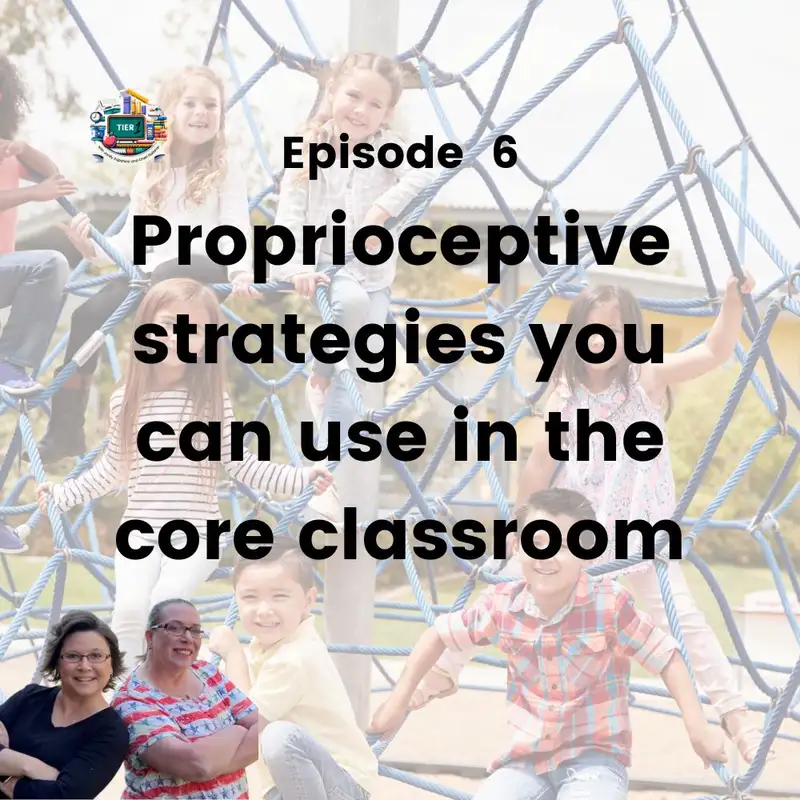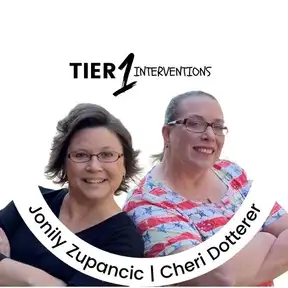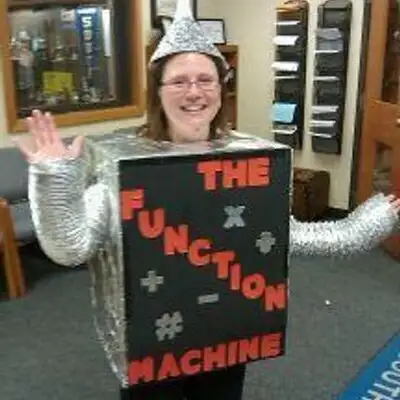
Proprioceptive strategies you can use in the core classroom: T1I S1 E6
Cheri Dotterer: by waking those
up, and doing that before you do
academics, you're preparing your
body for the ability to access
your education. Hello,
Jonily : everyone. Welcome to
tier one intervention podcast,
talking about strengthening the
tier one poor classroom with
academic and non academic
interventions, strategies and
techniques to meet the needs of
all students regardless of
ability or disability. I am
Jonily Zupancic, and I am here
with my partner and education
partner in crime. CHERI
daughter, who is going to help
us answer the question today.
Why do students not remember
when I teach lessons? When I
give quizzes, when I come back
to content? Why do students have
so much trouble retrieving the
information and recalling the
information after I've taught
it? So Sherry is going to
enlighten us today on everything
that's happening? That affects
memory, and retention of
content?
Cheri Dotterer: Hey, everybody
is great to be here. I'm Cheri
Dotterer. And yeah, do today a
little bit about all that non
academic part of what's
happening inside your brain. In
this episode of tier one,
interventions, I am sharing the
second half of my training on
the senses. Remember, last week,
we talked about the five senses,
plus we started talking about
proprioception. Today, we're
going to continue that
conversation, I look forward to
hearing what you have to say,
please put your comments down in
down in the comment section, or
do us a big favor and subscribe
to the podcast. So if you've
ever heard a therapist, say
you're not, don't just write
with your hands, but you write
with your whole arm. That's
absolutely true. Because the
nerves start in the brain and go
all the way down your arm, they
start at your fingertips, and
they go all the way up your arm
to your brain. And all of your
joints, you you've got 123 in
this finger, you've got two in
your thumb, you've got three in
this finger, you've got
sensation, and very complex set
of bones in your palm and in
your wrist. Then you've got the
bones that are in the nervous
system coming up your arm, so
that your arm can rotate. You've
got the elbow so we can bend,
you've got a shoulder, shoulders
a little bit more complex,
because it's going to go around
in a circle. And then we have
these nerves that are coming up
through there that go up into
our neck and back into our
brain. And then we have the
reverse, we have the nerves that
are coming back down to make the
motor function. So all we've
done so far is talk about the
messages coming from our body
going to our brain. We haven't
even reversed the response to
what it says afterwards. So all
the proprioception is doing is
sending messages to the brain as
to how much pressure that joint
needs to do the task that you're
asking it to do. So a lot of
kids that struggle with writing
have difficult time with this
proprioception. They either are
riding too heavy or too late.
They their fingers don't have
the control to keep the pencil
in the right place. So they have
awkward pencil grasp these other
things that that impact the way
the joints work. So I wrote some
actions down. These are motor
actions that impact the
proprioception brushing, whether
you're using a brush to brush
your hair, you could be using a
brush to brush your arm or your
leg. You could be using a brush
to paint a wall combing that
that motion. Chewing we talked
about. That first line is in
black, just because I was trying
to group them in groups. What do
you think I was thinking by
putting those in groups of color
the black bear the brushing the
combing. In the chewing, what do
you think I was thinking about
when I was putting them in that
kind of a group? Krista, how
about you? Ken was Where do you
think I was going? No, no, I
Unknown: was thinking like,
maybe it's like they're all our
movements. But then chewing is
not an arm movement. So I don't
know, I was trying to see what
they had in common to put them
together.
Cheri Dotterer: To net maybe you
have a good idea what I was
thinking,
Unknown: I was trying to think
of that proprioceptive feedback.
But I don't know about the
brushing definitely does. I'm
not sure about the combing
Cheri Dotterer: the comb, she
has a little bit, it's not as
much. But what I was thinking
was activities of daily living.
So in the world of OT, anything
that it is something that takes
care of yourself, that involves
like bathing, dressing, eating,
that was those kinds of
activities, I put in black. And
so I was thinking that, yeah,
they're not necessarily things
that we do in school, for
academics. But yet, there might
be things like that they do in
school. So the girls might be
spending a little bit too much
time in the bathroom, brushing
and combing and fixing their
hair. Sometimes the guys are
just as bad. But that's what I
was thinking when I was putting
grouping these things together.
Then I was looking at another
group. And this is one that I
was thinking about the classroom
carrying, pushing, pulling and
bouncing. And so a lot of times,
you may hear an OT talk about
pushing a bunch of heavy books
down the hallway, like on a cart
that pushing down the cart, or
pulling something out of the
cabinet, or carrying something
or I was thinking about
bouncing, like on one of the
therapy balls or something that
if there were one of the
adaptive seating. So it was
looking at that from that
perspective. So those it is
things that you can carry things
that you can push, they're going
to put this push and pull on the
joints, not on just your arms,
but your other parts of your
body as well. By waking those
up. And doing that before you do
academics, you're preparing your
body for the ability to access
your education. The third
column, I was thinking of tasks
that you have to do while
sitting. So cutting, squeezing
like squeezing putty or
squeezing the glue bottle or
something like that tearing
where you could be tearing
paper, and then taping you pull
it out of the dispenser, then
you've got to pull it to cut it
off. Those are things that you
do when you're more a little bit
more sedentary. And then there's
also jumping and climbing. And
the reason I put them on a
separate bouncing goes over here
as well as separate is because
they fall into this other
category, that second set of of
hidden sensories called the
vestibular system. And I'm not
going to go into those today,
we're going to save that one for
another session. Because just as
looking at this amount of
information today is enough to
get you thinking about things
that you can do in your lesson
plans to help prepare kids or
educate their education.
Unknown: As a middle school or
sixth grade teacher, I know it's
interesting that caring would be
something to use to stimulate
because we always worry about
how much they're carrying. To
us. That tends to be our worry.
Cheri Dotterer: There is some
ergonomic limitations on what
you're supposed to carry. But
there's also the balance where
if they go down to the weight
room, they're over stimulating
that, that lift where they're
lifting mega amounts sometimes
of weight. But yeah, if they're
carrying too much in front of
them, they're going to arch
their back. If they're carrying
too much on their back. They're
gonna have they're gonna arch
the other way. So yeah, with how
much they're carrying. As far as
books go. Learning how to
balance that ergonomically is
what you're thinking of there.
What I was thinking with
carrying, not just with carrying
books, but even carrying a cup
of coffee will stimulate your
hand to prepare for the another
activity. But Amy says in the
chat Sometimes we have kids
carry some books to another
teacher saying we need them.
When we see they need a sensory
break. Beautiful as what can you
tell me about? What do you see?
What do you notice? gives
everyone an entry point into the
conversation?
Unknown: Yeah, one thing I
noticed as far as that
proprioception, when you're
looking at kids who's doing a
lot of kneeling in their chair,
standing up sitting down, that's
when I do a lot of the, oh, you
know what I'm gonna send them to
go carry the books to another
classroom, or I'll have them do
you know what the whole class
let's do a two second plank or
something that gives them that
joint compression as well, just
so that they're more grounded to
do more of their work to in the
classroom.
Cheri Dotterer: Yeah, Jeanette
just used a technical word
called Joint compression. And
that's what we mean by putting
the joint back together. There's
also the terminology, when you
pull it apart, you may have
heard of eccentric and
concentric contraction. That's
that back and forth part. Okay,
I said, some, we sent some
technical stuff to you, we don't
expect you to know that. Yes,
while push ups. Another thing
that I am going to suggest, even
for sixth grade there, Christa
is having some of these footlong
bands, but pulling, bringing
around the back pulling just 30
seconds of that kind of activity
where they're just both
directions. And down the back.
You'd be surprised how that will
just wake up your upper body.
The other thing that OTS have,
that you may not have in the
classroom, but you have
playdough is therapy, and
therapy, it is how it comes in
different strengths. So if you
have have an OT in your school,
that can get you a couple
different strengths, kids can
choose what they want to do. So
it's an it's a different texture
of a poll, and a push and a
pinch, then what playdough is
playdough has gluten in it. So
if you have kids with a gluten
allergy, you've got to watch
playdough. Look at all the stuff
that's going on in your body
that you aren't even aware of as
a teacher that could make or
break. And that the limbic
system is a filing cabinet. And
every time you have a memory, a
moment of your day, it goes into
a folder folder goes into the
filing cabinet. On the outside
of that folder is an emotion.
It's red, yellow, green. When we
get into some of the more
technical behavioral things will
will add blue in there as well.
But if you just think like the
stoplight, is it good? Is it can
I do this again? Yellow? Oh, I
didn't really care for that. But
I'd be willing to try it again
or is it red, I am not going to
go there. Again, I think it's
really good for what Jonily has
in mind as far as the math goes,
because we totally is going to
be talking about involves a lot
of hand manipulation with the
activities that we're going to
do with the kids. Today,
Jonily : I wanted to focus on
the improving number sense piece
of that. When you get access to
this, these materials, you'll
get this recording of the
training, you'll get the PDF
resources, you'll get the audio
files of me teaching in
classrooms, even if you're a
seventh grade teacher, listen to
the first and second grade. Even
if you're a first grade teacher,
listen to the sixth and eighth
grade. Because you're going to
find these are not grade level
specific. You will find and pick
up on instructional strategies
and nuances of me teaching this
with kids that you can use in
your own classroom.
Unknown: I think my biggest
takeaway from today is just
looking at it from that whole
sensory piece. Even like the
Whisper counting that that time
to share the moving around to
find the partner like all those
different sensory pieces looking
at it from a math perspective as
well. I really will look at
things different for sure. Now.
For me, as I've worked with you,
I've been conscious on the fonts
I've been using for that visual
piece in colors. But one Aha I
had is that you look at students
who asked to get a drink as
they're trying to free class.
But then I'm like, What is this
just that they need to activate?
And so that's something that
going forward, I'm gonna keep
Yes, you can go get a drink. Now
obviously if we go 500 times in
a class that would be like,
Okay, we need to look at
something else. But oftentimes I
want to say Now, but because I'm
worried about the missed
instruction, but if they do need
to get themselves regulated, and
they need to get themselves
ready to learn, and that drink
is going to help them, then
really, if they stay in class,
they're going to be missing that
instruction. Anyway, Amy put
Cheri Dotterer: hers in the
chat, I'm going to read it, I am
going to start having kids take
a break to do some planks or
wall push ups, when I noticed
them getting up and down in
seats, sitting on their knees,
etc. I've never thought of that.
And it's, it is quick. And, Amy,
I'm glad that you were able to
take away something from the non
academic portion today that will
help your kids because your your
kids, the first graders are
really in a crucial spot, as far
as that difference between the
learning and the actual
applying. Thank you. But the
idea of my of what I want to do
on May 11, is take that stuff
that you saw up on the board, I
gave you like an overall
category chewing, balancing and
stuff. And I am working on
dividing activities from those
categories into what is really
good to do in tier one, what do
you really need to shift into a
tier two or tier three, and
really give you some guidance on
how to think about spontaneously
and just having your toolbox?
What is happening overall, with
different activities that you
hear about all the time. But
what's the best place to use
them? Those high school
students, I see the the
dimension chart, the grid paper
being so powerful, with eight
through 12, even as an OT. So
really take some time and think
through some of the last three
sessions. And the next two
moving forward are going to be
Jonily : powerful. So once that
wraps up our time today, and I
just have a couple of final
thoughts. We started today with
this question, why don't kids
remember. And Sherry walked us
through the complexity of the
brain, the body and the spirit,
and how all of those things
interact together to produce
access to learning. Typical
traditional math classrooms are
not structured in a way to allow
these positive sensory
experiences. I'm hoping that
through this making rectangles
session today that you've seen
ways that we can connect the
medical brain based cognitive
science, occupational therapy
world to what is natural in
learning, and have a place in
our math classrooms. So that
numbers come alive. So that
numbers are things that we not
only see the notation, but we
see the visual representation.
We hear all of the
representations. And we do the
representations of numbers by
drawing and building and
chunking so that our kids have a
stronger number sense and have a
better innate intuitive
understanding of the magnitude
of numbers magnitude, meaning
how small or large numbers are
the size of numbers, the value
of numbers, and most
importantly, have access to
higher level mathematics because
the notations and the symbols
are connected and associated
with the visuals and the tactile
pieces. They're not just another
mathematical notation,
mathematical notation comes to
life, and students understand
number better, so they're going
to be able to achieve higher and
they're going to have a stronger
math fact fluency and
automaticity to engage in deeper
level mathematics. So thanks,
everybody for being here. This
was session three, tier one math
interventions making rectangles.
Unknown: Lima says tier one
interventions was a sensitizing
workshop systematically thought
through but into an easy to
understand framework and well
presented. Thank you to you
both. Thank you Nilima. You've
been listening to tier one
interventions with Jonily
Zupancic and Cheri daughter.
Tier one interventions is
released on the first and third
Tuesday of the month. The
podcast is reported live on the
third Saturday of each month
except July 1 segment of the
podcast is released to your
favorite podcast app. Hear the
entire workshop go to tier one
interventions.com and Register
for our mailing list to get all
the news about the next episode.
Be sure to subscribe so you
don't miss the next episodes
release. Do us a favor give us a
five star rating and write a
review. Every vote matters. I'm
Nicholas King, an intern for
cheri Dotterer educational
consulting
Episode Video
Creators and Guests


